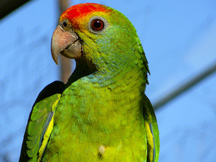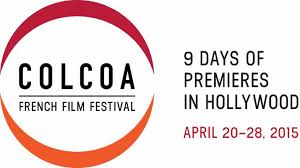
|
The Digital Polyglot
A publication of the Inland Empire World Language Association since 1985
April, 2015
Editor - Bethany Thompson
Asst. Editor - Trini Rios |
IN THIS ISSUE:
- French Film Festival in Hollywood - Free screening for high school students
- Tech Corner - Peardeck
- YouTube clip of the month - La Educación Explicada por un Niño
- Mini-grant winners
- Using Authentic Materials in the Class
- Quick Ideas
- Spanish Spelling Bee - First place $500
- Dear Poly
|

French Film Festival in Hollywood
Free screenings for high school students.
For the 8th year, COLCOA High School screenings will take place Tuesday April 21, Wednesday April 22, Thursday April 23 and Friday April 24, 2015 at 10:00 am at the Directors Guild of America theater complex, during the 19th COLCOA Film Festival, “A Week of French Film Premieres in Hollywood”.
The featured film will be selected no later than March 2015 and presented in French with English subtitles. This Premiere screening will be appropiate for American audience, ages 15 and older.
A pedagogical document about the film may be produced by AATF and offered to teachers participating in the program (to be confirmed at a later date.)
ADMISSION TO SCREENING IS FREE and open to all high school teachers and their students in Southern California.
RESERVATIONS ARE REQUIRED. For information and reservations
http://www.colcoa.org/education/high-school-screenings
|

Tech Corner
Each month we will explore a different aspect of technology that can help you in your classroom. This month: Peardeck. Peardeck is an interactive webtool that engages students. Teachers create a “deck” (like a slideshow) and can add oral questions about each slide. Students enter the session with a code. The questions are oral and students respond on a device. Even better, Peardeck has an “ask another question” which allows the teacher to ask questions on the fly. Get immediate feedback about student’s comprehension. Students can answer a variety of questions and even type in their own answers. The possibilities are endless in a language classroom! Check out the demo of how it works at http://www.peardeck.com.
|
YouTube Clip of the Month
La Educación Explicada por un Niño.
https://www.youtube.com/watch?v=SNrAqVZ6BxE
|
Mini-Grant Winners!
Congratulations to these IEFLA members on being selected to receive a $300 Mini-Grant.
- Salomon Alvarez, Desert Mirage High School, Thermal
- David Ganahl, Centennial High School, Corona
- Courtney Ziani, Heritage High School, Perris
- Lindsey Casper, El Cerrito Middle School, Corona
|
Using Authentic Materials In Class
Are you not sure how to incorporate authentic materials in all levels? Check out Madame Shepard’s blog. While the examples are in French, she shares valuable strategies to incorporate authentic materials in class.
For those of you who like a little bit more scholarly research and reading, Michigan State University has an entire newsletter dedicated to using authentic resources.
Or check out this Slideshare on Making the Most of Authentic Resources from the Central States Conference on Foreign Language Teaching 2015 Conference.
Spanishplans.org has created some lessons for you. |
Quick Ideas
Les stereotypes
An entire unit with listening, reading and writing activities on stereotypes.
French Children’s Stories
The French Experiment website has a variety of French children’s stories that are read by native speakers. Use the stories for ready and writing activities!
Más Música Miércoles
Looking for some fun ways to incorporate more music into your class? Need some Spanish songs? Mis Clases Locas has some great ideas. (Check out the music match up to get students to vote for their favorite songs and determine a winner!)
Questions about TPRS?
The aptly named TPRS Questions and Answers blog has answers and examples.
ACTFL Releases Seal of Biliteracy Guidelines
Read the guidelines on the ACTFL site.
Daily or Weekly Expression
Looking to renew and improve your French? You can get an expression sent to you daily or weekly from Expressio.fr. Sign up for their e-mail list to start expanding your vocabulary today.
Languages in the News
“Languages Build Bridges, French Ambassador Tells Students”
“Summer Immersion Saturday Spanish Program” |
2015 Inland Empire High School Spanish Spelling Bee Contest
Please join us as we gather to celebrate our first spelling bee contest at California Baptist University in Riverside, California. This event provides students the opportunity to showcase their ability to spell in Spanish. Additionally, winners will receive cash prizes to be used for educational expenses, including computers, software and school supplies.
WHEN: Saturday, April 25, 2015 at 10:30 a.m.
WHERE: Innovator’s Auditorium (Business Building 132), California Baptist University
For updates and most recent event information, please visit our Facebook page (Omega Phi).
Prizes/Scholarships
For the Championship Finalists:
1st Place: $500 + $100 for the teacher of the first place student for purchase of school supplies.
2nd Place: $350
3rd Place: $250
For official rules, word list, and a flyer, contact Noe Ruvalcaba at nruvalcaba@calbaptist.edu. |
Dear Poly

Dear Poly,
Teachers are always talking about using images from Google, but sometimes when I look at them and then copy them into my Powerpoint or use them with students they are pixelated and ugly and the students complain they can’t see. What am I doing wrong? How do I get images that look good that I can use with my students?
Pixelated in Pasadena
Dear Pixelated,
This is a common problem. First, you have to understand that each picture on the Internet has a file size. You are most likely choosing pictures that have a small files size and that means that there isn’t a lot of “information” about the picture and when you stretch it to full screen it ends up looking ugly and pixelated. The trick is finding “large” files to import.
This is easily accomplished in Google. Search for your image as you normally would and then click on “Images”. In that same toolbar click on “Search Tools.”

Once you do that you will have a variety of options for narrowing your search. To find a large picture, click on “Size” and then “Large.” This will filter your search and give you only large images. If you hover your mouse over any picture on the Google search page, a black bar will appear at the bottom of the picture showing a number like 1040 x 800. That’s the file size. The larger the number, the higher quality picture. BUT WAIT! You’re not quite done. What appears on the Google search pages are “thumbnails”; that is not the actual picture and not all of its information. Click on the picture and then “view image.” That will bring you to the page that will allow you to finally get a large, high quality picture.
These steps might seem difficult, but once you get the hang of it, you’ll be finding high quality images faster than Google can add them! Good luck.
-Poly
Do you have a question for Poly? Submit your question by filling in the form here. |
The Polyglot is a publication of the Inland Empire Foreign Language Association. For questions or comments, contact Bethany Thompson, editor, bethany_thompson@avusd.org or Trini Rios, trios327@gmail.com. Would you like to help with the Polyglot? Contact Bethany Thompson, editor, at bethany_thompson@avusd.org. |



